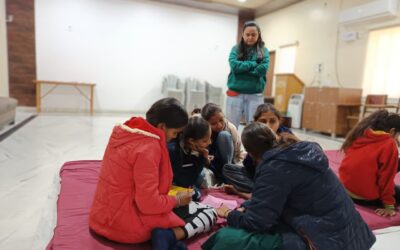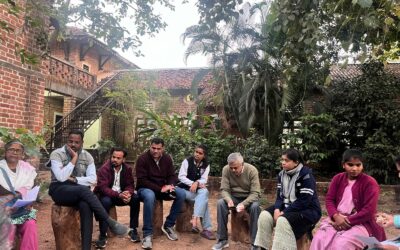“The art of communication is the language of leadership.” — James Humes
Language has always been a very critical instrument to humankind. They use it to communicate, in layman’s terms, they use it as a multi-purpose tool, from expressing love to hate, from sharing joy to the burst of anger, from the first cry of a newborn to the chants for the dead. Language is that tool that connects ears to our hearts.
Language, like music, can be simple, or complex. Some people prefer simple, easy-to-understand language, like playing a basic tune on the piano. Others like complex language, like a grand symphony with intricate notes and harmonies. Both can convey a beautiful message. Complex language may seem impressive, but it’s not always necessary. Just as not every moment calls for a grand performance, not every conversation needs complex language. The important thing is how well the language suits the moment and the audience.
Visva-Bharati And Me
Growing up in a village, my experience with language was simple and straightforward. However, moving to Visva-Bharati University introduced me to an environment where language became more than just a tool for basic communication; it became a key to academic success and social integration. The shift from casual village conversations to academic discourse demanded a new level of language proficiency.
During my first year of graduation, I attempted to join different projects, but I faced rejection multiple times after conversations with mentors. This made me realize the importance of having an extensive vocabulary and using “elite words” to communicate effectively with mentors and professors.
Over the following months, I practised using these words to showcase my knowledge during interactions with mentors.
Cut To The Fellowship …
In the serene lap of the Aravalli hills, my fellowship brought me together with peers from all over India. Hindi became our common ground, but for a Bengali speaker like me, it was a steep learning curve. I was determined to improve my Hindi, but the struggle wasn’t just about vocabulary or grammar. It was about clarity—my ability to convey thoughts in a way that others could easily understand.
You might wonder why I didn’t simply switch to English, a language I am more comfortable with. The truth is, even in English, I often complicate my communication with unnecessarily complex words. I recall an incident during a presentation by one of our mentors, Swati. She discussed a project involving giving money to villagers to study their consumer behaviour. I used the term “Quantitative Easing” an economic concept, to ask a question. Although my question was answered, many of my peers didn’t understand the term, and I was asked to rephrase it in simpler terms. It took me over 30 minutes to articulate what I initially intended to convey as “giving money to people to ease up their current situation.”
Realization
It was a moment of self-realisation that, despite priding myself on being a good communicator, I often struggled with simplicity. Writing this blog in plain language is a challenge. My thoughts naturally flow in complex structures, and breaking them down into simpler terms feels like learning a new language altogether.
Working in the development sector, my career depends on my ability to engage with grassroots communities—people who communicate in straightforward, everyday language. Yet, here I am, someone who often uses overly complex words, asking them to engage with me. It is quite funny when I think about it, but also a bit scary. How can I expect to connect with people if they don’t understand what I am saying?
Being Effective
This realisation has been a humbling experience, emphasising the significance of meeting individuals at their level. Effectively conveying ideas, particularly in my realm, necessitates using language that is approachable and straightforward. It is not about flaunting a sophisticated vocabulary or extensive knowledge; it’s about guaranteeing that my message is easily comprehensible and strikes a chord with the individuals I aim to connect with. Genuine communication is all about establishing meaningful connections, not about complicating matters unnecessarily.
Effective communication is about listening and adapting. In the development sector, we work with diverse communities, each with its own unique context, culture, and way of speaking. To truly connect, we must listen carefully and adapt our language to fit the listener’s world. This doesn’t mean oversimplifying or dumbing down the message but finding the right words to make complex ideas accessible.
I have made my share of mistakes. There were times when my well-intentioned but jargon-laden explanations left people confused or disengaged. I had to learn that it’s not about impressing others with big words or technical terms. It’s about ensuring that the person I am speaking to understands and feels included in the conversation. Every miscommunication became an opportunity to learn and improve my approach.
Mindful Communication
As I continue my journey in the development sector, I am committed to practising mindful communication. This means being aware of the words I choose and their impact on others. It also means being patient with myself as I am learning to simplify my language and convey my thoughts clearly. I have realised that it’s okay not to have the perfect words immediately. What matters is the effort to bridge the gap and make meaningful connections.
At the end of the day, I may not have the answer to the question posed in the title of this blog, “How to talk?”, but I now understand that its simplicity is what makes it beautiful, and the emotion it conveys is what makes it powerful. This simple act of talking allows us to break down barriers, build bridges, and undoubtedly transform the course of my journey.




0 Comments